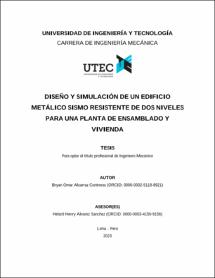Mostrar el registro sencillo del ítem
Diseño y simulación de un edificio metálico sismo resistente de dos niveles para una planta de ensamblado y vivienda
| dc.contributor.advisor | Álvarez Sánchez, Helard Henry | |
| dc.contributor.author | Alcarraz Contreras, Bryan Omar | |
| dc.date.accessioned | 2023-10-20T21:34:05Z | |
| dc.date.available | 2023-10-20T21:34:05Z | |
| dc.date.issued | 2023 | |
| dc.identifier.citation | Alcarraz Contreras, B. O. (2023). Diseño y simulación de un edificio metálico sismo resistente de dos niveles para una planta de ensamblado y vivienda [Tesis de Título Profesional, Universidad de Ingeniería y Tecnología]. Repositorio Institucional UTEC. https://hdl.handle.net/20.500.12815/335 | es_PE |
| dc.identifier.uri | https://hdl.handle.net/20.500.12815/335 | |
| dc.description.abstract | Actualmente los problemas sísmicos en el Perú han ido incrementando, esta fuera natural que es producto de los cambios climáticos y el calentamiento global, expone de manera severa a las personas y seres vivos en general. Así mismo las construcciones actuales en el Perú, sobre todo en el departamento de Ica no son lo suficientemente idóneas para resistir los estragos ocasionados por la actividad sísmica. Es por este motivo que, en esta tesis se busca realizar el diseño de un edificio metálico sismo resistente para una planta de ensamblado y vivienda ubicado en el departamento de Ica. Este diseño de edificio sismo resistente se sustentará mediante los fundamentos teóricos de la norma peruana E.030 y estadounidense ASCE/SEI 7-16 a fin de cumplir con el objetivo de la tesis, así para ello se planteará tres alternativas de edificio metálico que resultarán de la aplicación de la metodología de diseño de Karl T. Ulrich y Nigel Cross. Posterior a ello las alternativas de solución serán sometidas a una simulación recreando un evento sísmico de magnitud 9 en la escala de Richter en el software RFEM, donde según el análisis de resultados de deformación, desplazamientos y esfuerzos se procederá a definir la mejor alternativa de diseño de edificio metálico que cumpla con la lista de exigencias basado en un estudio previo. Así mismo, para el desarrollo del diseño de esta edificación se considerará la seguridad como punto primordial para el diseño. Al final de los resultados del análisis sísmico, se considerará un análisis de costos a fin de verificar la viabilidad del proyecto, de ser aceptable en términos de costo y seguridad, la empresa recurrirá a la aplicación de esta tesis para la construcción del edificio metálico. | es_PE |
| dc.description.abstract | Currently seismic problems in Peru have been increasing, this was a natural product that is a product of climate change and global warming, severely exposes people and living beings in general. Likewise, the current constructions in Peru, especially in the department of Ica, are not suitable enough to resist the damage caused by seismic activity. It is for this reason that this thesis seeks to design an earthquake resistant metal building for an assembly and housing plant located in the department of Ica. This earthquake resistant building design will be supported by the theoretical foundations of the Peruvian standard E.030 and the American ASCE / SEI 7-16 in order to meet the objective of the thesis, thus, three alternatives of metallic building will be proposed that will result of the application of the design methodology of Karl T. Ulrich and Nigel Cross. After this, the solution alternatives will be subjected to a simulation recreating a seismic event of magnitude 9 on the Richter scale in the RFEM software, where, according to the analysis of deformation, displacement and stress results, the best design alternative will be defined. metal building that meets the list of requirements based on a previous study. Likewise, for the development of the design of this building, safety will be considered as a primary point for the design. At the end of the results of the seismic analysis, a cost analysis will be considered in order to verify the viability of the project, if it is acceptable in terms of cost and safety, the company will resort to the application of this thesis for the construction of the metal building. | es_PE |
| dc.description.uri | Tesis | es_PE |
| dc.format | application/pdf | es_PE |
| dc.language.iso | spa | es_PE |
| dc.publisher | Universidad de Ingeniería y Tecnología | es_PE |
| dc.rights | info:eu-repo/semantics/closedAccess | es_PE |
| dc.rights.uri | http://creativecommons.org/licenses/by-nc-nd/4.0/ | |
| dc.source | Repositorio Institucional UTEC | es_PE |
| dc.source | Universidad de Ingeniería y Tecnología - UTEC | es_PE |
| dc.subject | Estructuras metálicas -- Diseño estructural | es_PE |
| dc.subject | Diseño resistente a terremotos | es_PE |
| dc.subject | Simulación | es_PE |
| dc.subject | Diseño estructural | es_PE |
| dc.title | Diseño y simulación de un edificio metálico sismo resistente de dos niveles para una planta de ensamblado y vivienda | es_PE |
| dc.title.alternative | Design and simulation an earthquakeresistant metal building with two levels for an assembly and housing plant | es_PE |
| dc.type | info:eu-repo/semantics/bachelorThesis | es_PE |
| dc.subject.ocde | https://purl.org/pe-repo/ocde/ford#2.03.01 | es_PE |
| dc.publisher.country | PE | es_PE |
| thesis.degree.discipline | Ingeniería Mecánica | es_PE |
| thesis.degree.grantor | Universidad de Ingeniería y Tecnología. Ingeniería Mecánica | es_PE |
| thesis.degree.level | Título Profesional | es_PE |
| thesis.degree.name | Ingeniero Mecánico | es_PE |
| renati.advisor.dni | 25564293 | |
| renati.advisor.orcid | https://orcid.org/0000-0003-4150-9156 | es_PE |
| renati.author.dni | 76341766 | |
| renati.author.orcid | https://orcid.org/0000-0002-5119-8921 | es_PE |
| renati.discipline | 713046 | es_PE |
| renati.juror | Bejarano Grández, Omar | |
| renati.juror | Charca Mamani, Samuel | |
| renati.juror | Ramos Saravia, José César | |
| renati.level | https://purl.org/pe-repo/renati/level#tituloProfesional | es_PE |
| renati.type | https://purl.org/pe-repo/renati/type#tesis | es_PE |
Ficheros en el ítem
Este ítem aparece en la(s) siguiente(s) colección(es)
-
Ingeniería Mecánica [73]






